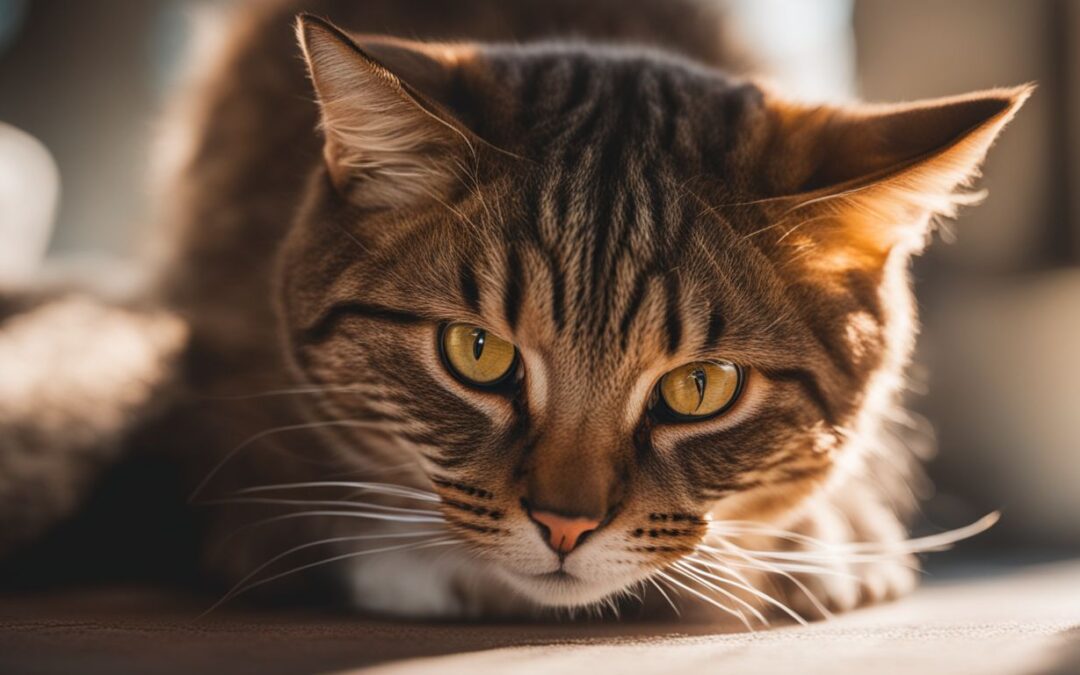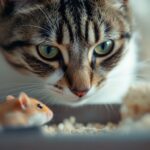Recently, my cat went on a little adventure, pouncing and munching on a moth that had wandered into our living room. It got me thinking – is it safe for cats to eat moths? I know many of us worry about the well-being of our furry companions, so I dove into some research to get answers.
Turns out, while many moths aren’t harmful to cats, there are exceptions and certain risks we should be aware of. In this blog post, I’ll delve into the reasons behind our cats’ fascination with chasing these fluttery insects and discuss how we can ensure their play doesn’t compromise their health.
Let’s keep that curiosity alive!
Key Takeaways
- Cats chase and eat moths because of their natural hunting instincts, need for energy, and curiosity about moving objects.
- While most moths are safe, some can be toxic or cause allergic reactions in cats, so it’s important to watch which moths your cat catches.
- To keep cats from eating moths, offer them interactive toys and use physical barriers like screens to prevent moths from entering the house.
- A balanced diet rich in animal protein and essential vitamins is crucial for a cat’s health; insects alone can’t provide all necessary nutrients.
- Watching out for potential allergens in a cat’s diet helps prevent health issues related to food sensitivities.
Why Do Cats Eat Moths?
Cats eat moths due to their instinctual hunting behavior and the energy they can gain from eating them. Curiosity also plays a role in cats pursuing and consuming moths.
Instinctual Hunting Behavior
My cat has a natural instinct to hunt, much like their wild ancestors. This drive compels them to pursue anything that moves, including moths and other insects. It’s this primal behavior that often leads them into chasing and catching these creatures as part of their play or hunting practice.
This pursuit doesn’t always mean hunger but fulfills their need for stimulation and exercise. Watching my cat leap and dart around after a moth showcases the deep-rooted behaviors tied to cats and hunting instincts, proving how much these actions are ingrained in them from birth.
Ingesting Energy Through Eating
Cats eat moths to ingest energy and fulfill their hunting instincts. For them, it’s a natural behavior that provides nourishment and mental stimulation. When cats catch and eat moths, they are actively seeking to acquire sustenance through the process of consuming these insects, which can provide a form of energy boost for them.
As part of feline nutrition, this activity aligns with their natural carnivorous diet.
Ingesting energy through eating is a vital aspect of feline behavior. Cats can derive nutrients from various sources, including moths and other small prey items they may encounter in their environment.
It’s an instinctual behavior deeply ingrained in their nature as hunters and carnivores.
Curiosity
When it comes to cats eating moths, curiosity plays a significant role. Cats are naturally curious creatures, and their instinct drives them to explore and investigate everything around them, including insects like moths.
Their inquisitive nature leads them to pounce on fluttering moths as part of their exploratory behavior. The allure of movement and the chase instinct can often lead cats to be curious about catching and consuming moths.
Insects that are safe for cats, cat behavior, entomophagy in cats, and feline diet intertwine with a cat’s natural curiosity when it comes to investigating these fluttering creatures.
Is it Safe for Cats to Eat Moths?
Eating moths can pose potential risks to cats, including ingesting toxic substances and the risk of allergic reactions. It is important to be aware of the potential harm and take precautions to discourage this behavior.
Potential Risks
When it comes to cats eating moths, there are potential risks to consider. Some moth species can be toxic to cats, leading to harmful effects if ingested. It’s essential for cat owners to monitor their feline friends’ eating habits and prevent them from consuming potentially harmful insects.
Additionally, allergic reactions and digestive issues may arise from a cat’s consumption of moths, which can lead to vomiting and other health concerns. Being aware of these potential risks allows me as a pet owner to take proactive measures in safeguarding my cat’s well-being.
Ensuring that the environment is free from toxic substances for cats is crucial in preventing any harm caused by ingesting moths or other insects. Monitoring for signs of allergies or digestive problems after interactions with moths is also important.
By being vigilant about these potential risks, I am able to keep my feline companion safe and healthy while allowing them to explore their natural hunting instincts without unnecessary harm.
Toxic Moth Species
Cats should avoid consuming moths to prevent potential harm and discomfort. Some moth species can be toxic to cats, leading to symptoms such as vomiting, diarrhea, and in severe cases, even neurological issues. Here are some toxic moth species that could pose risks to your cat:
- Luna Moths: While beautiful in appearance, Luna moths can be harmful to cats if ingested due to toxins present in their bodies.
- Io Moths: These colorful moths contain toxins that can cause adverse reactions in cats if consumed.
- Buck Moths: With venomous spines on their caterpillars, buck moths can cause skin irritation and allergic reactions if touched or eaten by cats.
- Saddleback Caterpillars: Cats should avoid contact with these striking caterpillars as their stings can cause pain and swelling.
These toxic moth species can pose health risks for cats and should be avoided in their environment as much as possible.
Allergic Reactions
Allergic reactions in cats from eating moths can lead to symptoms like vomiting, diarrhea, and skin rashes. It’s crucial to monitor my cat closely for any signs of allergic reactions after they eat moths.
If I notice any adverse effects, it’s important to seek immediate veterinary care to ensure my cat’s health and well-being. Monitoring my cat’s eating habits and being aware of potential allergens is essential in keeping them safe from allergic reactions related to ingesting moths.
How to Discourage Cats from Eating Moths
Discouraging cats from eating moths can be achieved by providing alternative toys and lures, setting up physical barriers, and redirecting their attention with food hunts. Read more!
Providing Alternative Toys and Lures
To discourage cats from eating moths, I find that providing alternative toys and lures is effective. Interactive toys like feather wands or laser pointers keep cats engaged, satisfying their hunting instincts without the risk of ingesting harmful insects.
Additionally, puzzle feeders and treat-dispensing toys stimulate mental and physical activity, diverting their attention from chasing moths.
Utilizing catnip-infused toys can also redirect your cat’s focus away from moths. These options not only prevent them from consuming potentially toxic insects but also promote a healthier and safer environment for your feline companion.
Now, let’s move on to exploring the use of physical barriers in deterring cats from eating moths.
Physical Barriers
To discourage cats from eating moths, I use screens on windows and doors to prevent moth entry. I also place sticky traps near light sources to catch moths before my cat does. In addition, I make sure to keep closets and cabinets closed to limit access to moths.
Redirecting with Food Hunts
When discouraging cats from eating moths, I redirect their attention by organizing food hunts with treats or interactive feeders. This satisfies their hunting instincts and keeps them occupied, reducing the likelihood of them pursuing moths.
Additionally, incorporating cat-friendly plants like catnip can also divert their focus away from chasing insects towards a more suitable alternative.
The Best Diet for Cats
Cats thrive on a diet rich in animal protein, essential vitamins and minerals. This helps to maintain their overall health and energy levels.
High Levels of Animal Protein
Cats require high levels of animal protein in their diet for optimal health. This is because they are obligate carnivores, meaning they need meat-derived nutrients to thrive. Animal protein supplies essential amino acids vital for muscle maintenance and overall well-being.
It also supports healthy skin, coat, and organ function, ensuring that cats receive the necessary nutrition from their food.
Incorporating animal protein into a cat’s diet provides them with taurine, an amino acid crucial for heart and eye health. Additionally, it aids in maintaining a healthy weight and energy levels.
By prioritizing this key component in feline nutrition, we can help ensure our cats lead healthy and active lives while preventing potential dietary deficiencies.
Essential Vitamins and Minerals
Essential vitamins and minerals are crucial for maintaining a cat’s overall health. A high-quality diet rich in animal protein, like taurine and vitamin A, is essential. Additionally, minerals such as calcium and phosphorus play a significant role in bone health.
It’s also important to ensure that the food does not contain potential allergens that could harm the cat.
Insects can provide some nutrients but should not be relied upon as the primary source of essential vitamins and minerals in a cat’s diet. While some insects offer nutritional value, it is paramount to prioritize a well-balanced commercial or homemade feline diet to meet all their nutritional needs adequately.
Avoiding Potential Allergens
Transitioning from ensuring cats get the right vitamins and minerals to maintaining a diet that steers clear of potential allergens is vital for their well-being. Keeping cats away from allergens like dairy, grains, and certain proteins can help prevent digestive issues and discomfort.
It’s important not only to provide high animal protein but also to steer clear of any potential allergens.
Creating a diet free from these harmful substances ensures my feline friend stays healthy and happy. High-quality, balanced nutrition without potential allergens is crucial in supporting my cat’s overall health.
Conclusion
In closing, cats eat moths due to their instinctual hunting behavior, curiosity, and energy ingestion. However, eating moths may pose potential risks such as toxic species and allergic reactions for cats.
To discourage this behavior, provide alternative toys and barriers or redirect their focus with food hunts. In addition to managing moth consumption, ensure that your cat’s diet comprises high animal protein levels, essential nutrients while avoiding allergens.
FAQs
1. Can I let my cat eat moths?
Yes, I can let my cat eat moths because they are one of the insects that are safe for cats. However, I always watch out for any signs of digestive issues afterward.
2. Are butterflies also safe for my cat to chase and eat?
Just like moths, butterflies fall into the category of insects that are generally safe for cats. So, if my cat catches and eats a butterfly, it usually isn’t a cause for worry.
3. Should I be concerned about toxicity in cats from eating certain insects?
Yes, while many insects including moths and butterflies are harmless, some can cause toxicity in cats or lead to insect-induced illness. That’s why I stay informed about which insects harmful to cats to keep my pet safe.
4. How do I know if an insect has made my cat sick?
If after eating an insect, such as a moth or another type not known to be safe, my cat shows signs of digestive issues or unusual behavior, it might indicate an insect-induced illness or toxicity. In such cases, I would seek advice from a vet immediately.






